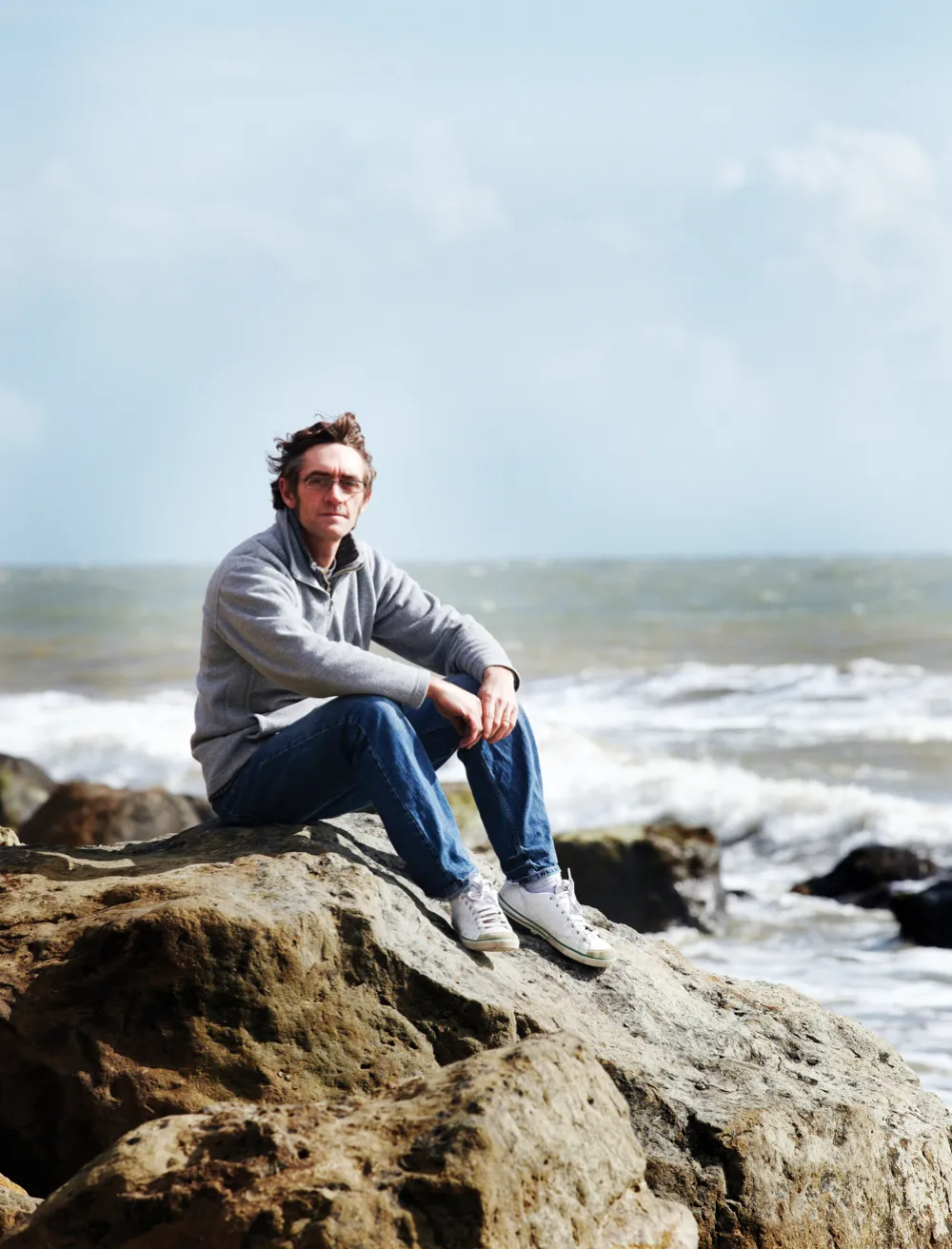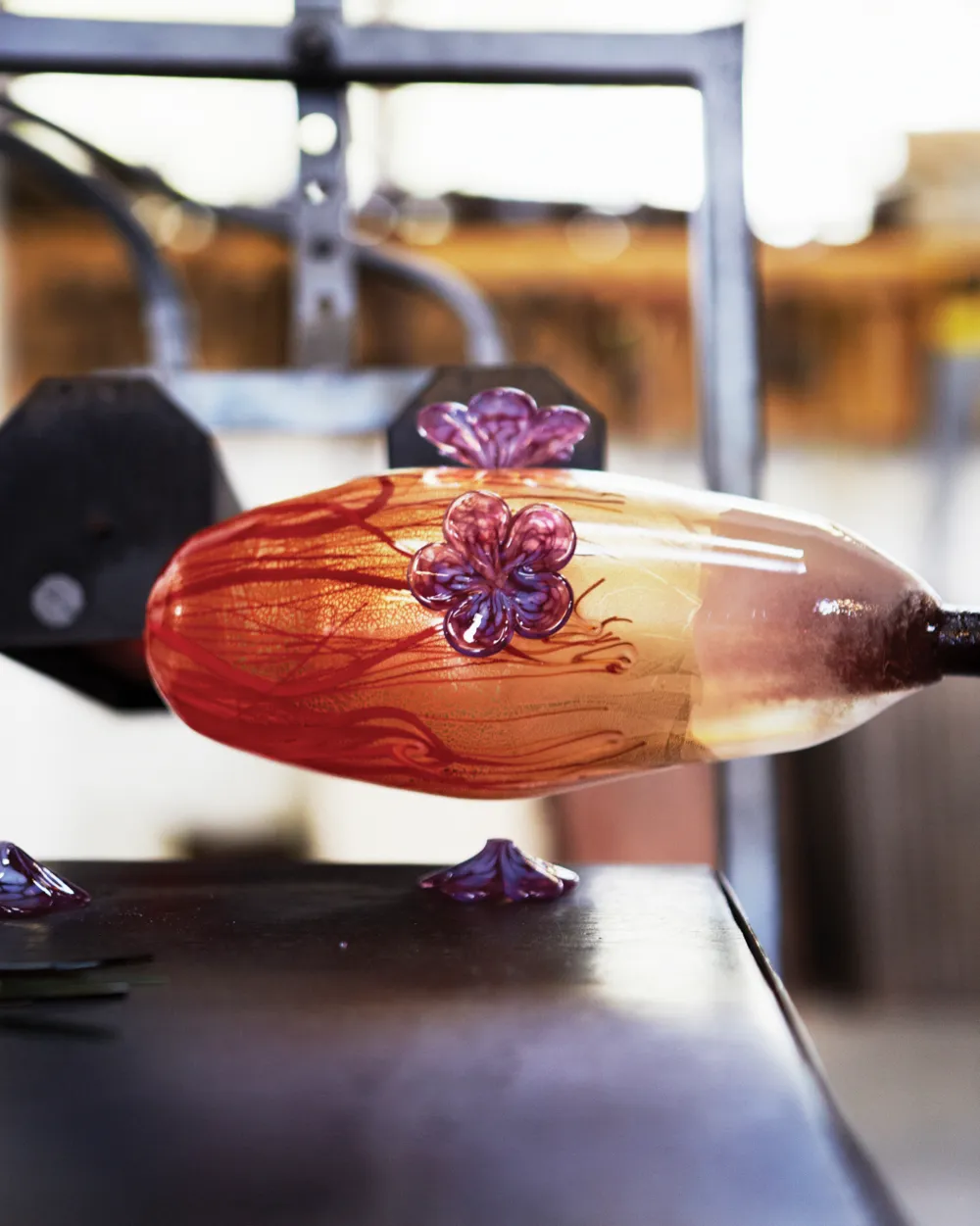A gentle sea breeze swishes through the beds of shrubs and semitropical palms that line the pathway to Isle of Wight Studio Glass in St Lawrence. Overhead, puffy clouds float across the coastal landscape, and ozone spices the air. At the centre of the scene is a 300-year-old solid stone barn, which is HQ for master glass-maker Timothy Harris and his team of five craftspeople.

On most mornings Timothy is here by 7.30am to check the furnaces and the cooling ovens, and to prepare materials and tools for another day’s glass-making – the studio makes its own ‘ingredients’, such as glass canes and flower-shaped murrinis, to retain complete control over the process. ‘Glass is my passion and it helps that I have a very patient wife,’ says Timothy, with a grin.
By 10am he’ll be ready to blow a piece of glass – perhaps a 2-3kg vase, decorated with signature flowers and leaves, and made lustrous with gold and silver leaf. The vase starts as an orange-hot globule of molten glass, to which various components are gradually added – large petalled flowers, green wands of foliage, and shards of pre-blown coastal colours. It’s coaxed into shape and pattern by Timothy’s breath and rhythm of movement.
A simpler piece will take an hour-and-a-half to make, while larger work can require up to three hours of blowing. There are no tea breaks, just continuous toil as Timothy darts from furnace to glass-maker’s bench to keep the molten glass supple as the form and decoration evolves. Sweat pours off him. Smoke rises from the glass shape on the end of the rod. No wonder pieces can cost upwards of £500.
Island life
Timothy is a master of technique, the leading artist at Britain’s largest studio glass workshop. He started making glass as a teenager (he’s now 47), inspired by his late father, Michael Harris, who co-founded Mdina Glass in Malta in 1968. ‘In the mid-Sixties, Dad was head of the glass department at the Royal College of Art. He had the best job in the country but he wanted to make his own glassware.’ The Maltese government was offering tax breaks to companies willing to train local people in new skills and so, with £5,000 of savings, Michael moved his family to the Mediterranean to set up a studio.

Producing contemporary designs in chunky shapes and with swirls of rich colour, he broke the mould of traditional crystal and Mdina Glass quickly became highly collectable. Michael’s ‘Fish’ vases are considered his signature pieces and fetch up to £1,500 today.
Michael returned to Britain in 1972 with his wife Elizabeth, a textile designer, and his sons Timothy and Jonathan. They chose to settle on the Isle of Wight because, like Malta, it offered the allure of island life and a steady supply of tourists to buy souvenirs – a novelty glass mushroom, perhaps, or something larger like a vase or bowl. They leased old farm buildings in the Undercliff, transforming the dairy into their home and the barn into a workshop and shop. Isle of Wight Studio Glass was born.
Inspired by the island terrain of rugged, sea-whipped coast and unspoilt, flower-filled chalk downland, Michael’s first Isle of Wight ranges were ‘Tortoiseshell’ and ‘Aurene’. But his landmark design was ‘Azurene’, which won a Design Council Award in 1979 for its pioneering use of silver and gold leaf as surface decoration. Still made today, its iridescent lustre, which gleams in the light, has become the studio’s trademark.
The apprentice
Timothy was too young to help with glass-making in Malta but, once back in the UK, his interest grew. ‘From the age of 13 I spent every summer in the hot shop. The first things I ever made – apart from a mess! – were little birds. It instilled the discipline of repetition, of doing something time and time again until you get it right.’

At 17, Timothy went on a year long course at Brierley Hill glass school in the West Midlands, where he was exposed to traditional English glass-making techniques. Two years later, he became a full-time apprentice at the Isle of Wight studio. It wasn’t all plain sailing. ‘Dad was a perfectionist, a hard taskmaster whose motto was, “Our best work will be done tomorrow”.’
His efforts paid off – in 1990, Timothy was awarded a grant by the Queen Elizabeth Scholarship Trust. ‘It allowed me to spend a few weeks studying at the Penland School of Crafts in North Carolina, which was completely absorbing,’ he says. A year later, he returned to the school as a technical assistant to some of America’s top glass artists, followed by a stint at Seattle’s Pilchuck Glass School, which was founded by renowned glass artist Dale Chihuly. He was invited to stay but family and the Isle of Wight pulled him back.
New ranges
Michael died in 1994. By that point, Timothy was running the hot shop and designing pieces, alongside his brother Jonathan and Elizabeth, whose love of flowers is evident in many of the ranges. Jonathan left to set up his own glass business in Ironbridge in 2000 but Timothy has continued to produce Isle of Wight Studio Glass designs. He develops a new range every six months and an annual body of work for the studio’s Collectors Club. Very reasonable prices for smaller pieces such as paperweights (£10) or pears (£30) make it easy to start a collection. ‘Many of our most avid collectors started with a mushroom or a bird,’ says Timothy.

The more complex designs, such as ‘Undercliff’ (introduced in 1987), ‘Nightscape’ (1988), and ‘Flower Vase’ (2001) are generally made by Timothy himself. His favourite items to create are the individual graal and cameo pieces, which involve a lot of highly-skilled work, applying powdered enamels to the hot glass to create layers of colour and carving into them once cold. These are the most collectable too, and are snapped up almost as soon as they are made.
Timothy loves the relaxed pace of island life and the coastal landscape, which constantly feeds into his work. ‘We have very good, clean light here, and there are no distractions. You bury yourself in glass-making, with all the inspiration that comes from being on the island. I hope Dad would be proud that I’ve carried on being innovative with the material. I’m always thinking about glass – it’s at the forefront of my mind. It always has been.’
Collecting Isle of Wight Studio Glass
AR expert Mark Hill is a keen collector of contemporary glass
‘Compared to ceramics, glass is completely undervalued,’ says Mark Hill. ‘For a few hundred pounds you can have a piece of art in glass'.
‘Michael Harris was a very skilled glass-maker. Timothy is a supreme technician and he has an incredible touch too, an artistic touch that is part of him, not something that can be learnt.
‘Timothy is a world-class studio glass artist in his own right. I’m most excited about his graal and cameo pieces – the techniques are very complex and time-consuming.
‘If I were to invest, it would be in one really good, more expensive piece, rather than lots of little things. Glass like this is very hard to make so, in collecting terms, it has everything going for it.’
Isle of Wight Studio Glass, Old Park,
St Lawrence, Ventnor,
Isle of Wight
01983 853526; isleofwightstudioglass.co.uk
FEATURE: Caroline Wheater
PHOTOGRAPHS: Brent Darby